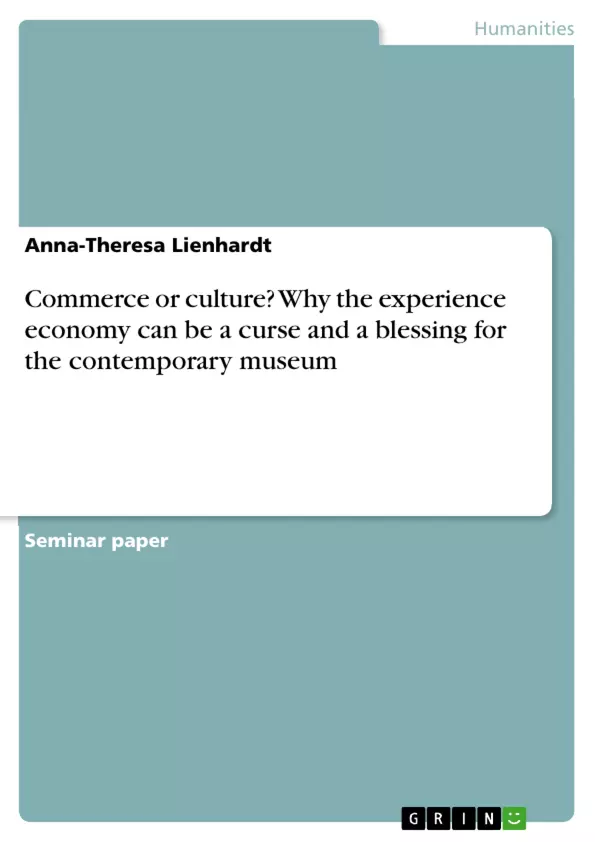The research paper investigates the reasons why Joseph Pine and James H. Gilmore's theory of the Experience Economy can be a blessing or a curse when adapted on contemporary museums' displays. As an aggressive competitive leisure environment surrounds contemporary museums this examination is important for directors and curators to think about the image and management style of their institution. The research paper identifies the museum's main purposes like education, preservation and recreation to find out whether Pine and Gilmore's strategy helps to support them or rather undermines their position. Furthermore, the study works out the primary aspects of Pine and Gilmore's marketing strategy which are inter alia to provide visitors with enhanced experiences - educational, esthetic, escapist and/or entertaining ones - and also to make profit out of these approaches. Examples, case and research studies of authors that operate within the scopes of both culture and commerce are used to find out which impacts Pine and Gilmore's strategy can have on museums. On the one hand it turns out that the strategy is able to increase customer rates as well as to enhance visitors' experiences. One main outcome is that predominantly science museums can benefit from Pine and Gilmore's approach when they manage to combine education and experience in a proper way. On the other hand the strategy also leads to an immense commercialization of museums which increasingly try to attract customers with the help of extra facilities or experience opportunities. Above all art museums seem rather to suffer from that shift. They are accused of losing the focus on their main purpose which is the display of art. Out of these reasons, it is stated that the theory of the Experience Economy can not be a useful tool for every museum. It depends on nature and type of the museum and also on how exactly the strategy is applied to.
Inhaltsverzeichnis (Table of Contents)
- Introduction
- Approach
- Context
- The museum's original purpose
- Pine and Gilmore's theory of the Experience Economy
- Why the experience economy's theory can be both a curse and a blessing for the contemporary museum
- Why it can be a blessing
- Why it can be a curse
- Entertaining or educating, commerce or culture?
- Conclusion
Zielsetzung und Themenschwerpunkte (Objectives and Key Themes)
This research paper aims to explore the impact of Joseph Pine and James H. Gilmore's Experience Economy theory on contemporary museums, examining why this approach can both benefit and hinder museums in the modern context.
- The evolving role of museums in a competitive leisure environment
- The tension between the museum's traditional purposes (education, preservation) and commercialization through experience-driven strategies
- The implications of applying the Experience Economy theory on different types of museums (art museums vs. science museums)
- The potential for enhancing visitor experiences through innovative technologies and programming
- The risks of losing focus on core objectives (art display, knowledge dissemination) due to excessive commercialization
Zusammenfassung der Kapitel (Chapter Summaries)
The introduction sets the scene by highlighting the contemporary museum's position within a competitive leisure environment. It introduces the concept of the Experience Economy and its potential impact on museum displays. The paper also outlines its approach, focusing on literature research and juxtaposing opinions from both economic and cultural perspectives.
The following chapter delves into the context of the study by exploring the traditional purposes of museums, emphasizing their roles as collectors, educators, and spaces for cultural enrichment. The chapter also introduces Pine and Gilmore's Experience Economy theory, outlining its key concepts and implications for museums.
The core analysis explores the potential benefits and drawbacks of applying the Experience Economy theory to museums. It examines how this approach can enhance visitor experiences through innovative technologies and programming while simultaneously raising concerns about commercialization and the potential loss of focus on core objectives. The chapter also considers the application of the theory to different types of museums.
Schlüsselwörter (Keywords)
This research paper explores the impact of the Experience Economy theory on contemporary museums, particularly focusing on the tension between commerce and culture in museum displays. Key concepts include: contemporary museums, experience economy, visitor experiences, commercialization, education, preservation, art museums, science museums, leisure environment, marketing strategies.
- Quote paper
- Bachelor of Arts Anna-Theresa Lienhardt (Author), 2013, Commerce or culture? Why the experience economy can be a curse and a blessing for the contemporary museum, Munich, GRIN Verlag, https://www.hausarbeiten.de/document/279980


